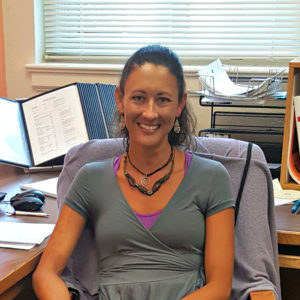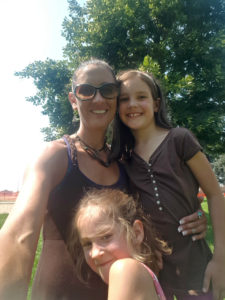Katrina Boschmann has always preferred to work with people, and she says people seem drawn to her as well.
“I’m a good listener,” she said, “and can empathize with anyone. I can always find something in a person that we can connect about, and that I can value in that person.”
It’s fitting that Boschmann found her calling in a career in school counseling. She recently graduated from the School of Education’s Counseling and Career Development master’s degree program, a program she said helped her to add skills and knowledge that support her natural inclinations to help others.

From artist to teacher
After receiving her B.A. in visual arts from a private Mennonite college, Boschmann spent years helping others heal through art therapy at various clinics and treatment centers in Kansas. When she moved to Colorado, she worked in banking, quickly realizing that wasn’t the career path for her.
Boschmann became a paraprofessional at an alternative high school in Greeley, working primarily with students with special needs. The principal, upon learning she had an art degree, encouraged Boschmann to move into teaching art classes. After earning her teaching license from the University of Northern Colorado, Boschmann taught art at various alternative high schools in Greeley for the next 10 years.
In addition to teaching art, Boschmann taught the Discovery class, a social-emotional curriculum each student at the alternative high school was required to pass in order to stay enrolled at the school.
“I really liked teaching the Discovery classes,” she said. “I got to know the students and make a stronger connection with them than I could as an art teacher. I could really build relationships and make a positive impact on them.”
The Discovery curriculum is based in counseling theory, said Boschmann, with concepts rooted in counseling training, such as transactional analysis and cognitive behavior therapy incorporated into the curriculum.
“It was really effective,” she said.
From teacher to student
It was during her time teaching art and Discovery that Boschmann realized counseling might be the field for her to pursue.
“I carpooled with four people from the school, two of whom were counselors,” said Boschmann. “One of those counselors had graduated from the CCD program at Colorado State University. She told me about the program and encouraged me to check it out – she thought it would be a good fit for me.”
Boschmann applied and was accepted to the CCD program. She resigned from her teaching position at the high school, and began teaching art classes two days per week for a homeschool enrichment program in Greeley.
Soon after beginning her graduate studies, Boschmann’s personal life took a hit when she went through a divorce. Now a single mom to her two daughters, as well as a student and part-time employee, she realized she wouldn’t be able to complete CCD program in two years like her peers. Boschmann reached out to the CCD faculty, particularly her adviser, for guidance.
“In the end, it took me four years to complete the two-year program,” said Boschmann. “The faculty was really supportive of me throughout the process, and understanding of my position as a working, single mom and student. They gave me advice on how to space out my classes, and when to take certain classes.”
From student to counselor

As a student, Boschmann said she was able to incorporate her basic counseling theory knowledge and her visual arts background to the CCD courses, while learning new approaches to working with different people. In particular, Boschmann said the creative counseling kit she put together as part of a class assignment includes a number of art therapy tools she will offer students as alternative ways to express themselves. In addition she plans to use soul collage and sand tray therapy.
“Soul collage allows a student to use pictures to collage images. Then the student writes stories about the resulting picture as though they are in the picture,” explained Boschmann. “It offers a way for students to express themselves visually, then explain what that visual image means to them.”
Sand trays, she said, are her favorite non-verbal modality to use when counseling children and adolescents. Her first experience with sand tray therapy was during her last internship, when her supervisor incorporated the modality into therapy, sparking Boschmann’s interest in the concept.
“We think and experience emotions in images – we process experiences nonverbally,” she explained. “As we get older, we’re better able to put those experiences into words; however, trauma experience is often stored in the part of our brain that works in images, symbols, and emotions. Sand trays help to connect the nonverbal, image-heavy part of our brains with the cognitive, linear, and analytical part of our brains.”
For children and adolescents, Boschmann said, this tool is particularly effective in counseling.
“Kids naturally gravitate towards sand trays, because it allows them to express themselves by creating ‘worlds’ in the trays,” she explained. “They use miniatures, creativity, and sand to put together a visual representation of an experience they might not have the ability to put into words.”
The concept and application of sand trays fascinated Boschmann. She took an advanced practicum to learn more and is now certified in the first two levels, allowing her to work with children and adolescents. In the future, she said, she’d like to complete all 10 levels of the certification process to be fully certified for all ages.
Taking on the future
Throughout her four years in the CCD program, Boschmann has balanced her roles as a mother, an employee, and a student. She credits the faculty, and her friends and family, for their support and assistance.
Laurie Carlson, an assistant professor and coordinator of the CCD program, shared: “Katrina has shown extreme resilience in completing her master’s degree here in the School of Education. From leaving her Mennonite childhood, through divorce and single parenting during our program, Kat has persevered.”
Having persevered, Boschmann is excited to begin a new journey this fall as a school counselor at Greeley Central High School. She looks forward to implementing her creative counseling kit and counseling knowledge, and is confident she will make a difference in the lives of her students. Whether they take advantage of her creative tools or they just want to sit down and talk with Boschmann, thanks to the CCD program, she is equipped to offer the students at GCHS the support they need.
“I highly recommend this program,” she said. “It’s a great program. The faculty is willing to work with you when you encounter bumps in the road. Most of them have been through challenges as well, and they’re counselors. They get it.”
For someone considering a future in school counseling or career development, Boschmann advises, “Check out the classes and talk to the faculty – you’ll get a feel for the program, and know if it’s right for you.”
The School of Education is part of CSU’s College of Health and Human Sciences.